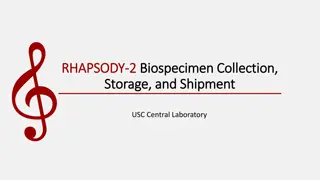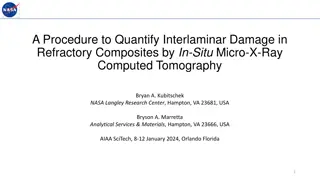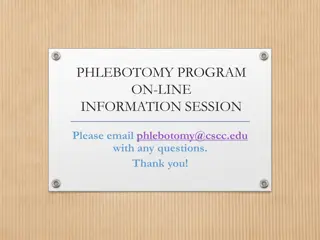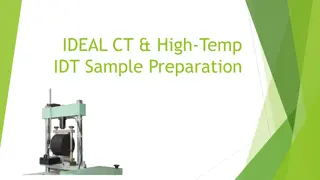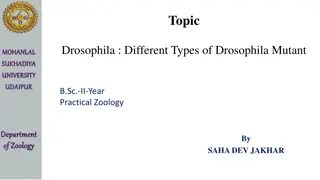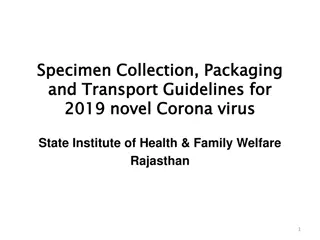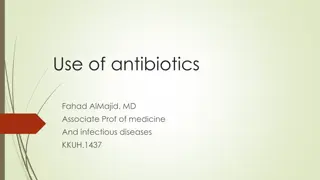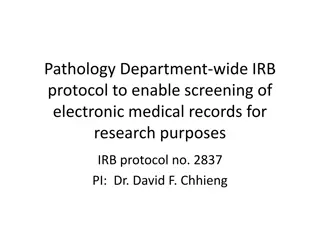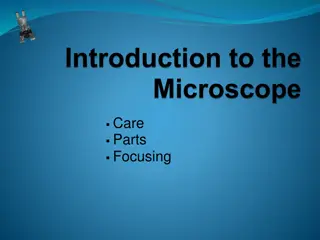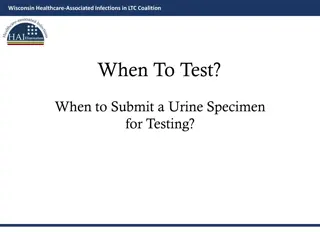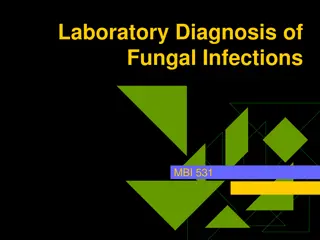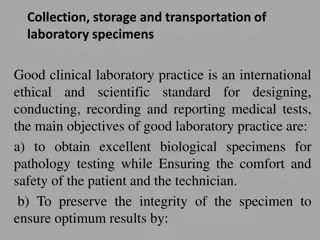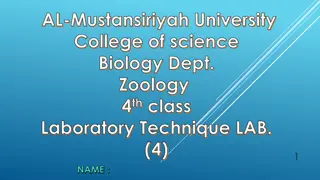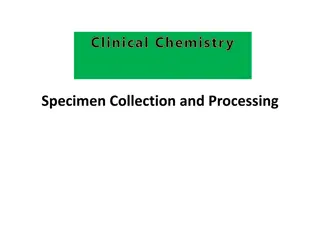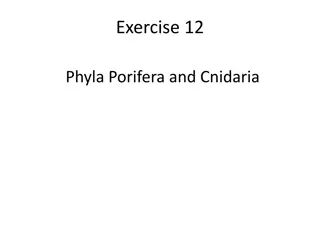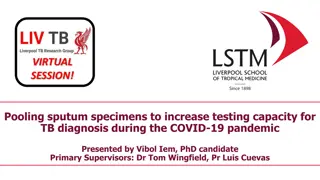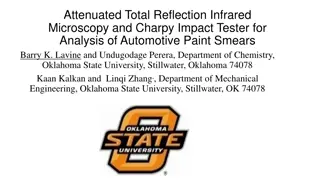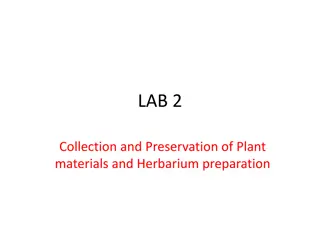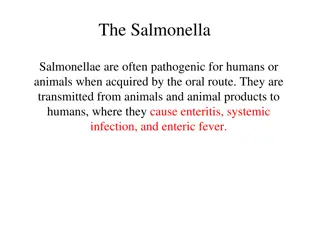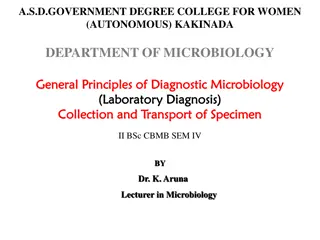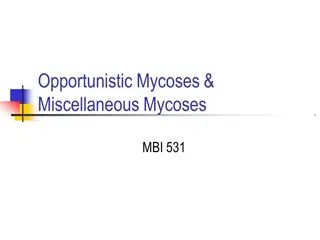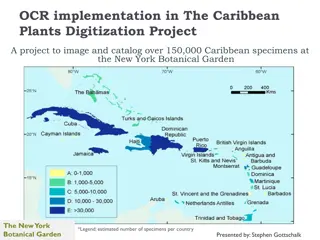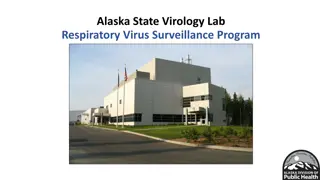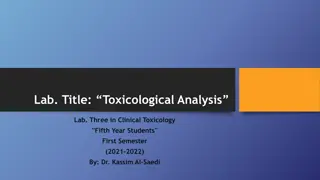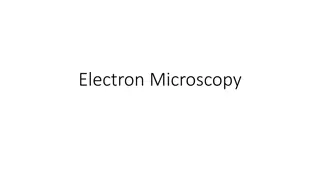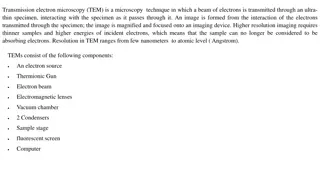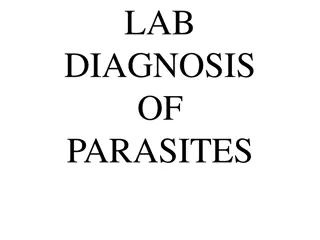Biospecimen Collection, Storage, and Shipment Overview at USC Central Laboratory
This overview covers the types of biospecimens collected, specimen collection schedule, supplies, protocols, and shipping instructions at the USC Central Laboratory. It includes details on whole blood collection for different assays, storage procedures, and shipment to USC Labs and Charles River Lab
0 views • 21 slides
Understanding Mosquito Larvae: Identification and Anatomy
Explore tutorials from GLOBE Mission Mosquito focusing on identifying mosquito larvae specimens including Anopheles, Aedes, and Culex genera. Learn about the morphological characteristics, habitats, and anatomy of mosquito larvae to understand their role as disease vectors. Detailed descriptions and
11 views • 22 slides
Procedure for Quantifying Interlaminar Damage in Refractory Composites Using Micro-X-Ray CT
This study presents a method to quantify interlaminar damage in refractory composites through in-situ micro-X-ray computed tomography. The procedure aims to capture the progressive failure in ASTM-sized specimens, providing empirical data for improving simulations of composite materials. Various spe
6 views • 19 slides
Monumental Trees of Italy - A Natural Legacy of Grandeur and Cultural Significance
Italy boasts a rich heritage of monumental trees, defying the challenges of nature and human exploitation to grow into majestic and culturally significant specimens. These grand trees symbolize the enduring bond between nature and humanity, embodying naturalistic, aesthetic, and historical values. T
7 views • 23 slides
Adaptations of Aquatic Specimens, with a Focus on Sea Snakes
Aquatic specimens, particularly sea snakes of the subfamily Hydrophiinae, exhibit fascinating adaptations for their fully aquatic lifestyle. These marine snakes are uniquely adapted for life in the sea, with specialized features such as paddle-like tails, compressed bodies, and the ability to respir
0 views • 16 slides
Comprehensive Overview of the CSCC Phlebotomy Program
Explore the CSCC Phlebotomy Program, approved by NAACLS, offering a two-semester sequence with clinical experience. Learn about the curriculum, program instructors, and what phlebotomists do in a typical day. Discover the impact of phlebotomists in healthcare by collecting blood specimens crucial fo
0 views • 50 slides
Culture Media
Culture media play a crucial role in isolating bacteria from clinical specimens. Water, electrolytes, peptone, agar, meat extract, yeast extract, and blood/serum are essential constituents used in culture media. These components provide nutrients, solidifying agents, and growth factors necessary for
1 views • 26 slides
Optimizing Asphalt Material Testing Procedures
This document outlines the sample preparation procedures for both IDEAL-CT and High-Temp IDT testing, including specifications for compaction heights, air void targets, and conditioning requirements. It also provides instructions on preparing specimens, estimating weights, and refining values for Gy
0 views • 9 slides
Exploring Different Types of Drosophila Mutants at Mohanlal Sukhadiya University
Discover the various Drosophila mutants, including Yellow Type, Ebony, Orange-eye, White Eye, Eyes Absent, Leg-headed, and Curly Wings, with unique genetic characteristics and visible phenotypes. This practical Zoology insight provides an in-depth look into mutations affecting body color, eye pigmen
0 views • 11 slides
Guidelines for 2019 Novel Coronavirus Specimen Collection
The guidelines outline the responsibilities of clinicians in collecting clinical specimens for testing 2019-nCoV, emphasizing the importance of following case definitions and using proper procedures for specimen collection, packaging, and transport. It also provides details on selecting patients for
0 views • 14 slides
Understanding Fluorescence Microscopy: Principles and Applications
Fluorescence microscopy, pioneered by British scientist Sir George G. Stokes, reveals hidden details in specimens using fluorescent dyes that emit light of longer wavelengths. This innovative technique allows for visualization of cellular components that are otherwise colorless under conventional mi
0 views • 19 slides
Fundamentals of Taxonomy Explained: From Classification to Nomenclature
Taxonomy, derived from Greek roots, encompasses the science of classifying organisms and understanding their variations, evolutionary relationships, and naming conventions. It involves description, identification, classification, and nomenclature of both living and extinct organisms. The practices o
1 views • 39 slides
Optimizing Antibiotic Use in Treating Infections
Antibiotics are vital for treating and preventing infections, but research shows they are often prescribed unnecessarily or misused. Evidence-based guidelines from IDSA can assist in choosing the right therapy based on accurate infectious disease diagnosis and microbiological understanding. Proper s
1 views • 51 slides
Guidelines for Specimen Rejection and Acceptance
Specimens may be rejected if improperly labeled, insufficient quantity, delayed receipt, incompatible requisitions, or in improper containers. General and specific criteria are outlined for various tests including microbiology, urinalysis, blood cultures, and more. Adherence to these criteria helps
0 views • 11 slides
Overview of Veterinary Clinical Pathology and Importance of Anticoagulants
Veterinary clinical pathology involves the laboratory diagnostics and analysis of bodily fluids and tissues to support the diagnosis, treatment, and prevention of diseases. This field encompasses interpreting blood tests, blood smear examinations, and the use of various anticoagulants in specimen co
3 views • 46 slides
Pathology Department IRB Protocol for Electronic Medical Records Screening
Pathology Department's IRB protocol enables the screening of electronic medical records for research purposes, allowing members to review patient records and pathology slides. By fulfilling specific requirements and obtaining blanket IRB approval, researchers can access and analyze patient data for
0 views • 16 slides
Mastering Microscope Focusing Techniques
Understand the essential parts of a light microscope, the magnification process, general procedures for handling a microscope, focusing techniques for specimens, and the relationship between magnification and field of view. Learn how to avoid damaging the microscope and achieve optimal results durin
0 views • 18 slides
**Wisconsin Healthcare-Associated Infections in LTC Coalition: Urine Testing Guidelines**
The Wisconsin Healthcare-Associated Infections in LTC Coalition provides guidelines on when to test and submit urine specimens for testing in long-term care facilities. The focus is on reducing unnecessary urine testing, introducing tools like the UTI Stoplight Tool and the When To Test-Nursing Tool
5 views • 16 slides
Laboratory Diagnosis of Fungal Infections: Specimen Collection and Transport
In the laboratory diagnosis of fungal infections, proper collection and transportation of specimens are crucial for accurate diagnosis and treatment. Different sites and types of specimens require specific collection techniques to avoid contamination and ensure viability. From superficial to systemi
0 views • 29 slides
Best Practices for Clinical Laboratory Specimen Handling
Good clinical laboratory practice emphasizes the proper collection, storage, and transportation of laboratory specimens to ensure accurate and reliable test results. Key aspects include obtaining high-quality specimens, maintaining specimen integrity, and following standard precautions to prevent co
6 views • 6 slides
Common Laboratory Techniques in Zoology - Urine and Stool Specimen Analysis
In the Biology Department at Al-Mustansiriyah University, students learn laboratory techniques for collecting and analyzing urine and stool specimens. The process involves random urine sample collection, urine tests for chemical components, urine culture, stool specimen analysis for pathological con
0 views • 10 slides
Fossorial Specimens: Mole and Caecilian Adaptations
Fossorial specimens, including the mole and caecilian, are uniquely adapted for subterranean burrowing. The mole, commonly known for its wedge-shaped head and reduced eyes, lives in tunnels and feeds on small worms and insects. On the other hand, the limbless caecilian, resembling a worm, thrives in
1 views • 25 slides
Laboratory Related CRFs for Pharmacokinetics Study
This collection encompasses various CRFs related to laboratory procedures in the context of Pharmacokinetics for a study. It includes forms for enrollment, specimen storage, safety laboratory results, and specific days for sample collection. The CRFs detail the storage, collection, and documentation
0 views • 14 slides
Proper Clinical Chemistry Specimen Collection and Processing
Proper collection, identification, processing, storage, and transport of various types of biological specimens are crucial for obtaining accurate diagnostic test results. Different types of specimens, such as whole blood, serum, plasma, urine, feces, saliva, and various bodily fluids and tissues, ar
0 views • 18 slides
Exploring Diversity in Porifera and Cnidaria Phyla Through Lab Observations
You were exposed to the wide array of animals in the Porifera and Cnidaria phyla in a lab exercise. Understanding the distinguishing features of each group, their roles in the environment, and the structures crucial for identification is key. Focus on bold-faced structures and labeling on diagrams a
0 views • 12 slides
Pooled Sputum Specimens for TB Diagnosis in COVID-19 Pandemic
Tuberculosis (TB) diagnosis faces challenges during the COVID-19 pandemic, impacting testing capacity. This study by Vibol Iem explores the feasibility of pooling sputum specimens to enhance testing efficiency using Xpert MTB/RIF or Xpert Ultra. The research aims to assess the reliability and cost-e
0 views • 16 slides
Analysis of Automotive Paint Smears Using Charpy Impact Tester
The study focuses on developing a procedure utilizing a Charpy impact tester to generate and analyze automotive paint smears, particularly in crime scene investigations. These paint smears are complex mixtures of various paint layers, making analysis challenging. The impact-induced smearing process
0 views • 22 slides
Plant Collection and Preservation Techniques
Explore the process of collecting and preserving plant materials for herbarium preparation. Learn about the importance of plant documentation, including dry and wet preservation methods. Understand why plant collection is crucial for systematics studies and serving as a reference collection for name
0 views • 25 slides
Best Practices for Rectal Palpation in Veterinary Medicine
Rectal palpation is a crucial diagnostic method in veterinary medicine for assessing the reproductive health of animals like cows, buffaloes, mares, and camels. This technique helps in determining the normal and abnormal conditions of genital organs, aiding in pregnancy diagnosis and differentiating
0 views • 18 slides
Metamorphic Rocks Hand Specimen Laboratory Analysis
Explore a comprehensive laboratory examination of various metamorphic rock hand specimens, identifying types of metamorphism, mineral compositions, textures, and formation conditions. Utilize images for visual aid and delve into metamorphic processes and rock characteristics.
0 views • 4 slides
Overview of Salmonella Infections and Pathogenicity
Salmonella bacteria, often transmitted through contaminated food or drink, can cause various infections in humans and animals. They are identified by their morphology, and classified into different species and subtypes. The pathogenesis of Salmonella infections varies, with some species infective pr
0 views • 18 slides
Collection and Transport of Specimens in Diagnostic Microbiology
Successful laboratory investigations depend on the proper collection and transport of specimens. This involves selecting adequate samples that represent the diseased area, avoiding contamination, obtaining specimens before administering antimicrobials, ensuring biosafety, proper documentation, and t
0 views • 20 slides
Field Visits and Herbarium Techniques in Plant Taxonomy
This material covers the field visits and specimen collection process in plant taxonomy, emphasizing the need for complete specimens with tools required. It explains the pressing, drying, mounting, and preservation techniques involved in creating herbarium specimens for study and research purposes.
0 views • 19 slides
Understanding Cryptococcosis: Causes, Symptoms, and Diagnosis
Cryptococcosis is a fungal infection caused by Cryptococcus neoformans, affecting immunocompromised individuals. The disease presents with various clinical features, including pulmonary and extrapulmonary manifestations. Laboratory diagnosis involves examining specimens such as serum and CSF for the
0 views • 44 slides
Digitization Project for Caribbean Plants at New York Botanical Garden
The Caribbean Plants Digitization Project at New York Botanical Garden aims to image and catalog over 150,000 specimens from the Caribbean region. Through OCR and data parsing, the project focuses on curation, barcoding, cataloging, and imaging of specimens. Expeditions since 1895 have contributed t
0 views • 15 slides
Alaska State Virology Lab Respiratory Virus Surveillance Program
The Alaska State Virology Lab's Respiratory Virus Surveillance Program accepts specimens from across Alaska, ranging from large hospitals to single physician clinics. They collect specimens representing CLI/ILI weekly and are interested in Severe Acute Respiratory Illness samples, among others. The
1 views • 6 slides
Analytical Toxicology: Techniques and Sample Analysis in Clinical Toxicology
Analytical toxicology involves the observation, identification, and measurement of foreign compounds in biological and other samples, such as urine, blood, stomach contents, nails, hair, and DNA. Various techniques are used to isolate and identify drugs and poisons present in these samples. This fie
0 views • 12 slides
Understanding Electron Microscopy: A Comprehensive Overview
Electron microscopy (EM) is a powerful technique used in biomedical research to visualize detailed structures of various specimens at high resolution. The process involves an electron gun, electromagnetic lenses, specimen holder, and imaging systems. There are two main types of electron microscopes:
0 views • 12 slides
Understanding Transmission Electron Microscopy (TEM)
Transmission Electron Microscopy (TEM) is a powerful microscopy technique that uses a beam of electrons to create high-resolution images of ultra-thin specimens. It provides detailed information on topography, morphology, composition, and crystalline structure. Sample preparation for TEM is crucial,
0 views • 10 slides
Laboratory Diagnosis of Parasites: Methods and Clinical Specimens
Laboratory diagnosis of parasitic infections involves techniques such as demonstration of parasites, immunodiagnosis, and molecular biological methods. Clinical specimens for diagnosis include blood, urine, genital specimens, sputum, and tissue biopsy/aspiration. Chyluria, a condition with milky whi
0 views • 24 slides
